
The winter moth is a moth of the family Geometridae. It is an abundant species in Europe and the Near East and a famous study organism for evaluating insect population dynamics. It is one of very few lepidopterans of temperate regions in which adults are active in late autumn and early winter. The adults use endothermy for movement in these cold temperatures. The females of this species are virtually wingless and cannot fly, but the males are fully winged and fly strongly. After the initial frosts of late fall, the females emerge from their pupae, walk to and up trees and emit pheromones in the evening to attract males. After fertilization, they ascend to lay, on average, around 100 eggs each. Typically, the larger the female moth is, the more eggs she lays.

The common white wave is a moth of the family Geometridae. The species was first described by Carl Linnaeus in his 1758 10th edition of Systema Naturae. It is found throughout the Palearctic region. Their habitat is deciduous forests and their surroundings.
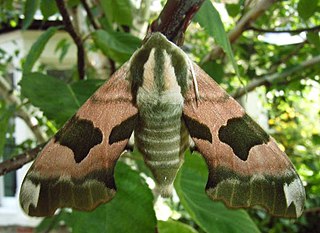
Mimas tiliae, the lime hawk-moth, is a moth of the family Sphingidae. It is found throughout the Palearctic region and the Near East, and has also been identified in Canada's east and western provinces and in northern Spain (Europe). The species was first described by Carl Linnaeus in his 1758 10th edition of Systema Naturae.

The Lasiocampidae are a family of moths also known as eggars, tent caterpillars, snout moths, or lappet moths. Over 2,000 species occur worldwide, and probably not all have been named or studied. It is the sole family in superfamily Lasiocampoidea.
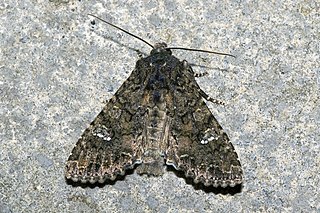
The cabbage moth is primarily known as a pest that is responsible for severe crop damage of a wide variety of plant species. The common name, cabbage moth, is a misnomer as the species feeds on many fruits, vegetables, and crops in the genus Brassica. Other notable host plants include tobacco, sunflower, and tomato, making this pest species particularly economically damaging.

Cerapteryx graminis, the antler moth, is a moth of the family Noctuidae. It is a common species throughout most of Europe but is lacking in the very dry southern regions. The northernmost occurrence is Iceland, and above the Arctic circle. It also occurs in Siberia and in North Mongolia. The species has been introduced to North America. In the Alps it rises to an altitude of 2100 meters.

The grey chi is a moth of the family Noctuidae. The species was first described by Carl Linnaeus in his 1758 10th edition of Systema Naturae. It is distributed throughout Europe, although it is not present in southern Spain and Greece, as well as northern Fennoscandia. It is also found across the Palearctic including Central Asia, to the Russian Far East but not in Japan.

The poplar grey is a moth of the family Noctuidae. It is found throughout Europe.

Apamea remissa, the dusky brocade, is a species of moth of the family Noctuidae. It is distributed throughout Europe and Turkey, ranging across the Palearctic realm to Siberia, Manchuria and Japan. It has also been reported from Alaska.

Apamea sordens, the rustic shoulder-knot or bordered apamea, is a moth of the family Noctuidae. The species was first described by Johann Siegfried Hufnagel in 1766. It is distributed throughout Europe, east across the Palearctic to Central Asia and to China and Japan. It also occurs in North America.

Daphnis nerii, the oleander hawk-moth or army green moth, is a moth of the family Sphingidae. It was described by Carl Linnaeus in his 1758 10th edition of Systema Naturae.

Thomas de Grey, 6th Baron Walsingham, of Merton Hall, Norfolk, was an English politician and amateur entomologist.
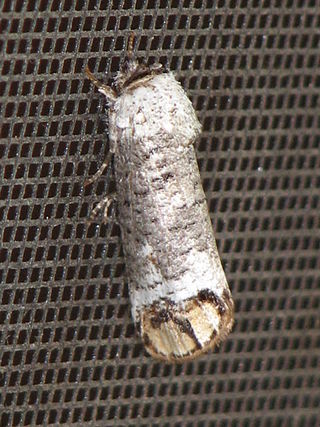
The Cossidae, the cossid millers or carpenter millers, make up a family of mostly large miller moths. This family contains over 110 genera with almost 700 known species, and many more species await description. Carpenter millers are nocturnal Lepidoptera found worldwide, except the Southeast Asian subfamily Ratardinae, which is mostly active during the day.

The black arches or nun moth is a small Palaearctic moth. It is considered a forest pest.

The small lappet moth is a moth in the family Lasiocampidae. The species was first described by Carl Linnaeus in his 1758 10th edition of Systema Naturae. It is found throughout Europe and parts of Asia.
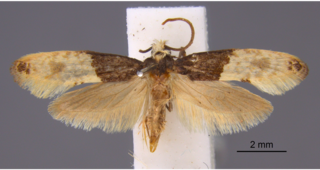
Trichophaga tapetzella, the tapestry moth or carpet moth, is a moth of the family Tineidae, commonly referred to as fungus moths. It is found worldwide.

Spilonota ocellana, the bud moth, is a moth of the family Tortricidae. It is found in the Palearctic realm, from North Africa and Europe to Iran, eastern Russia, China, Korea, and Japan. It is also present on Madeira and in North America.
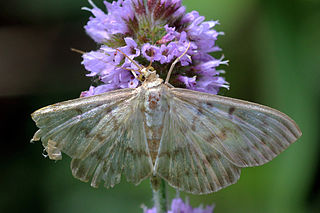
Patania ruralis, the mother of pearl moth, is a species of moth in the family Crambidae. It was described by Giovanni Antonio Scopoli in 1763. It is found in Europe.

Anomologinae is a subfamily of moths in the family Gelechiidae.


















